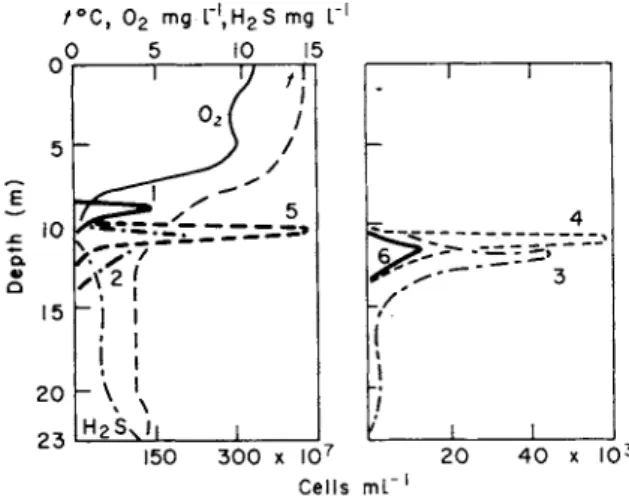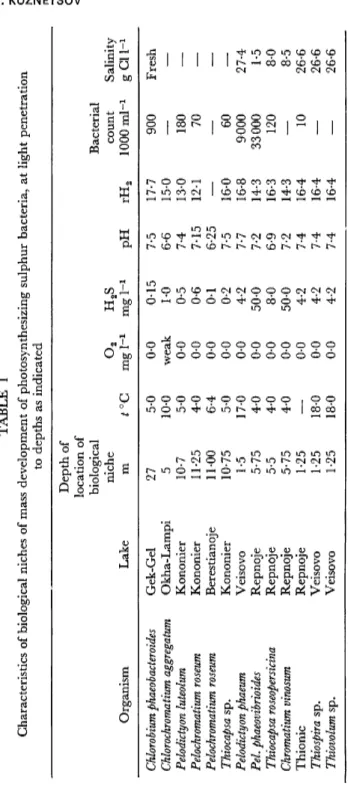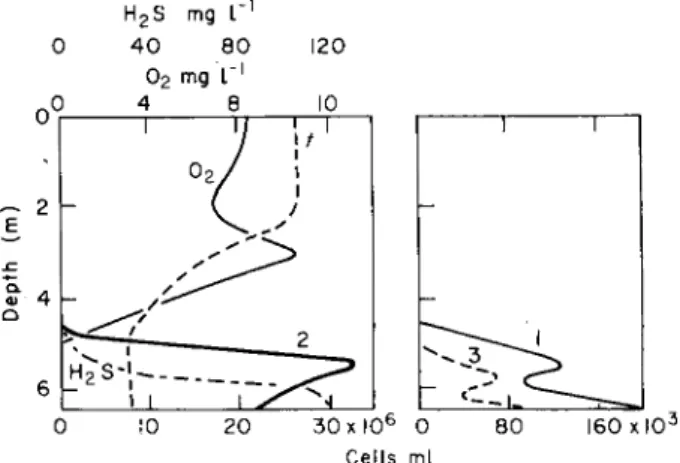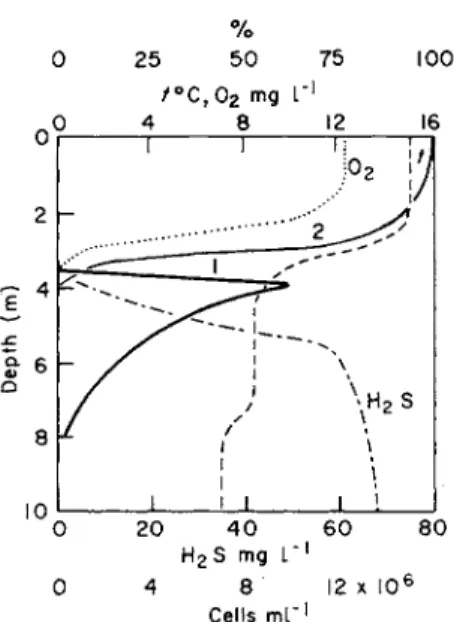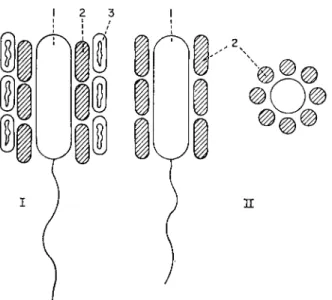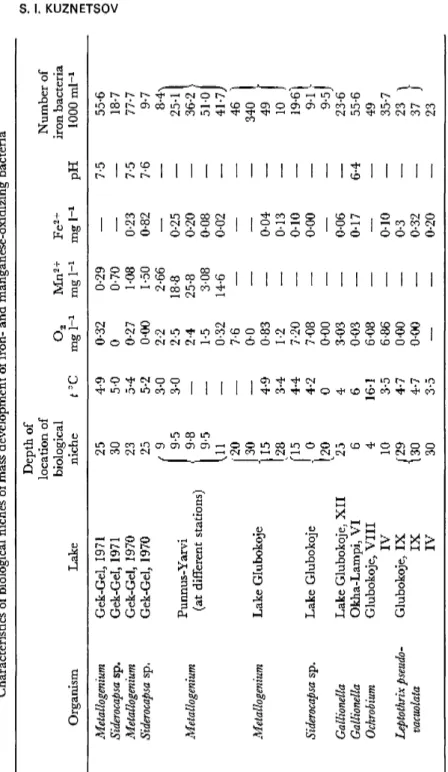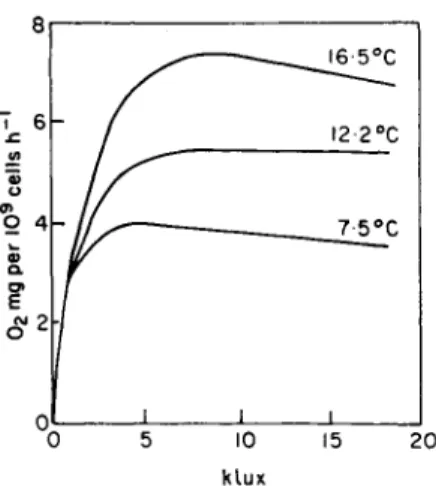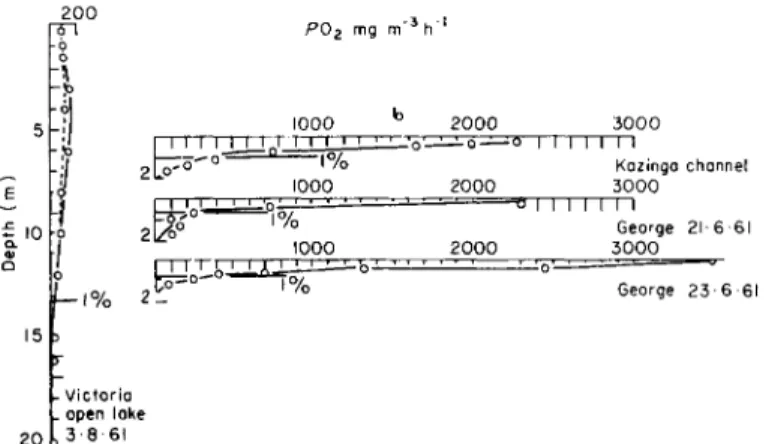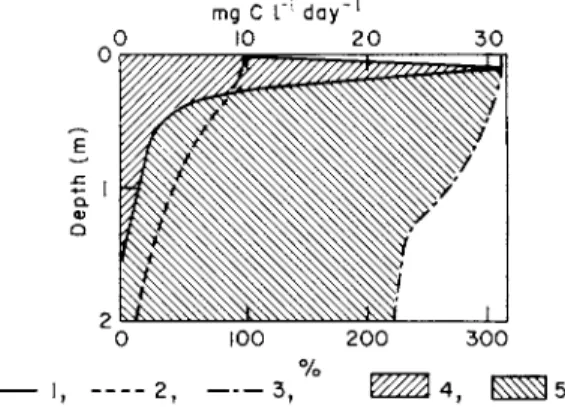microbiology
S. I. KUZNETSOV
Institute of Microbiology, USSR Academy of Sciences, Moscow, USSR
1 Introduction . . . . . . . . . . . 1
2 Ecological niches . . . . . . . . . . 5
3 The ecology of photosynthesis . . . 14
3.1 Ecology of phytoplankton photosynthesis . . . 14
3.2 Ecology of bacterial photosynthesis . . . 19
4 Intensity of bacterial reproduction . . . . 2 2 5 Intensity of sulphate reduction and chemosynthesis in lakes . . . 26
5.1 Current interpretations of the concept of "chemosyn thesis" . . 26
5.2 Intensity of sulphate reduction in nature . . . . . 28
5.3 Intensity of chemosynthetic processes in nature . . . . 31
6 Intensity of molecular nitrogen fixation . . . . . . 34
7 Degradation of organic matter . . . . . . . . 38
8 Conclusions . . . . . . . . . . . 43
References . . . . . . . . . . . 45
1 Introduction
Although the concept "ecology" may be variously formulated, the most general definition would apparently describe ecology as a science dealing with the interactions between the organism and its environment.
Some investigators, writes Brock (1966), emphasize the characteristics of the environment while others stress the relationships among the organisms. The former include limnologists, oceanographers and soil scientists, and the latter plant and animal ecologists who are chiefly concerned with relationships existing between the organisms them- selves, and who take into account the environment in as much as it
1
2 S. I. KUZNETSOV
enables them to account for the distribution of individual species of organisms in nature. As far as ecological microbiology is concerned, it covers both these areas of study, since microorganisms are so inti- mately linked up with the environment that the latter must be taken into serious consideration at all times. As regards microorganisms themselves, their interrelationships, both symbiotic and parasitic, have been repeatedly demonstrated.
As the development of given microorganisms in nature depends on the chemistry of the environment as well as on their relationships with other organisms, both these parameters may characterize the optimum ecological niche for microbial development. In the course of their development microorganisms in turn affect the environmental chemistry and provide conditions favourable for other species. The elucidation of these relationships constitutes a major interest of microbial ecology.
The origins of ecological microbiology are associated with the ideas of Louis Pasteur concerning the roles of the "infinitely small" in nature, while the foundations of that science were laid by Winogradsky and Beijerink who considered microorganisms to be closely associated solely with the environment and believed that searches for living organisms should be started after a knowledge of phenomena occurring in nature had been gained.
After Pasteur, the work of Koch and his school greatly contributed to the development of research methods without, however, touching at all on problems concerning the dynamics of biological processes occur- ring in nature. Koch's methods were employed to isolate new organisms and to study their morphology and physiology in pure culture, although those studies failed to give a clear idea as to what are microbial activities in nature. Such was the status of ecological microbiology at the begin- ning of this century.
Thereafter, microbiological studies of natural media developed at a rapid rate and went a long way to approach their goal. Those by Forel, Birge, Juday, Tinemann and others largely elucidated the physico- chemical properties of reservoirs.
Waksman (1927, 1941), ZoBell (1946), Senez (1951) and others have summarized the results of studies of the physiology and distribution of individual bacterial groups in the soil, silt deposits and lake and sea water and have arrived at a number of conclusions regarding the roles of micro- organisms in biochemical processes occurring in those environments.
Microbiologists specializing in the field of microbial ecology of course sought to investigate the functions of true microflora in its natural state. In order to understand the responses of microorganisms to changes in physical and chemical properties of the environment, it was necessary to have a pure culture. The nature of pure cultures is, however, such that it precludes serious ecological generalizations.
Indeed, the absence of other organisms and, consequently, the lack of competition for energy and food sources create biologically unnatural conditions. The ecologist is interested in actual, real properties of the microorganism he studies rather than in those which the culture may acquire in an environment far from the natural one and in the absence of struggle for the substrate. Thus, while the study of pure cultures may elucidate its potentialities and point out the direction in which its morphology and physiology may alter, such investigations, which are confined to microbial physiology and biochemistry, cannot elucidate the activities of microflora in nature.
Winogradsky (1947) believed that such activities were made up not of individual processes but rather represented a single self-regulating process. Microbial functions are controlled by the competition for the energy-supplying substance and are limited by the physicochemical conditions of the environment. One cannot but agree with Winogradsky that the study of actual processes carried out by microbes must be based not only on the consideration of individual microbial species but, in the main, on the study of microbial communities as a whole acting directly in their natural environment.
Such an approach does not replace the method of pure cultures, which is still used whenever necessary. However, the study of microbial communities as a whole with due regard to physicochemical properties of the environment should contribute to a better understanding of ecological problems, which cannot be resolved by the classical methods involving microbial counts and physiological studies of pure cultures.
The foregoing also applies to morphological studies of microorgan- isms: on an artificial medium that is too rich for a given organism, one may observe what may be called hypertrophy of that organism.
Morphological properties remain normal only if the organism is culti- vated on a "poor" medium closely approaching the naturally occurring substrate.
Recent studies in microbial ecology have been reviewed in Brock's monograph (Brock, 1966) where it is pointed out that efforts in this
4 S. I. KUTZNETSOV
field have been concentrated on the following: (1) investigation and determination of the limits of ecological conditions under which the organism lives in nature; (2) studies, in pure culture, of the growth and behaviour of the organism upon a change in individual ingredients of the nutrient medium; (3) studies of responses of naturally occurring microbial populations to environmental changes; and (4) morpho- logical and behavioural studies of organisms placed in those biotopes from which they had been previously absent. Brock (1966) adduces several examples to show how a culture isolated from the natural environment alters its morphology under laboratory conditions.
Experimental studies undertaken with the use of new techniques have enabled Brock to conclude, after Winogradsky and Beijerink, that pure culture studies are very important in ecological investigations, although one must remember at all times that pure cultures may have great ecological distinctions from natural ones. In other words, the inter- pretation of laboratory investigations should always be adjusted to take account of field observations. On the basis of Winogradsky's ideas and their elaborations, the main principles of ecological microbiology appear to be as follows :
1. Acquaintance with a given naturally occurring phenomenon, viz.
the determination of the physicochemical conditions in which it occurs and identification of the microbial groups involved. To put it differ- ently, it is necessary to characterize the ecological niche for particular microbial groups.
2. Identification of members of the major microbial groups playing principal roles in biological processes and the study of the more important aspects of their physiology and relationships with other organisms.
3. Determination of their activities in nature in communities with other species, using a quantitative approach.
The present review is chiefly concerned with the characteristics of ecological niches for individual microorganisms and with the deter- mination of intensities of individual microbiological processes in the course of turnover of various substances in reservoirs. Such a quantita- tive evaluation of individual processes was largely impossible at the time of Winogradsky and became a practical proposition only recently with the advent of new methods of ecological microbiology. To attain a complete understanding of microbial ecology one must possess a
totality of information on microbial physiology and morphology in conjunction with physical and chemical data on environmental properties.
2 Ecological niches
In nature, the chemical composition and physical properties of water varies over a wide range not only in different water bodies but also within the same lake. Since many microorganisms can grow within a very narrow range of fluctuations of water constituents, their natural development can proceed only in strictly limited biotopes. That is to say, certain "biological niches" are created in the reservoir where individual microbial species encounter minimal competition on the part of other members of the microflora as well as optimal physico- chemical conditions for their growth.
A biological niche cannot be regarded as a certain steady-state system. The organisms contained in it make use of definite substances for their metabolism, transforming them into other substances indifferent for them or inhibiting their development.
For that reason, the entire system of a biological niche must be open. There should be a dynamic equilibrium between the ingress and egress of individual substances required for a given organism.
This may be associated with the fact that the microflora of a neigh- bouring biological niche provides conditions favourable for the develop- ment of the organism in question.
The formation of zones with the optimum development of particular species is affected most of all by the following factors : the degree of illumination and aeration; inflow of nutrients, of reduced compounds of sulphur, iron or manganese, of dissolved gases (methane or hydro- gen) ; and the acidity and the oxidation potential of the medium.
Biological niches are observed most distinctly in meromictic lakes where deep-water layers are enriched with salts and do not take part in the spring or autumn water circulations. These layers usually do not contain dissolved oxygen and are enriched with hydrogen sulphide or ferrous salts. This creates a vertical gradation of oxidants and reductants causing the formation of distinct biological niches.
The characteristics of ecological niches with mass-scale development of particular phytoplankton species have been studied in detail by Findenegg (1971) in a series of 600 experiments staged in 30 lakes of
6 S. I. KUZNETSOV
Austria. That author has shown that the mass development of species at a particular depth depends not only on light intensity and water temperature but also on the trophic status of the lake, while the rate of accumulation of carbon dioxide per unit biomass varies greatly from one species to another.
The ecological niche was found to be particularly distinct for 0 scxllatoria rubescens in the period of lake stratification. Mass development ofthat species was observed at depths of 10-12 m where the temperature was near 7 °C, light intensity did not exceed 10 per cent ofthat at the surface, and nutrient elements appear to have been flowing out from the hypolimnion.
The development of photosynthesizing sulphur bacteria in mero- mictic lakes at the depth of 10-12 m in the upper layers of the hydrogen sulphide zone was observed by Issatschenko (1914) in Lake MogiFnoje, Kuznetsov (1942), Jegorowa (1951), Dolgov (1955), Sorokin (1966a, 1970) and others in Lake Belovod, by Jimbo (1940), Takahashi and Ichimura (1968) in lakes of Japan, by Kuznetsov and Gorlenko (1973) in lakes of the Mari ASSR, and by many other authors. The distribu- tion of these organisms was studied in greatest detail by Kuznetsov and Gorlenko (1973) and Gorlenko and Kuznetsov (1972) in Lake Kononier in the Mari ASSR and by Gorlenko et al (1973) in Lake Gek-Gel in the Azerbaijan SSR.
Observations of the vertical distribution of photosynthesizing sulphur bacteria was observed in the chasm lake Kononier at the depth of 22 m and the results were considered in relation to the ecological conditions of the environment. During the observation period, in September 1970 (Fig. 1), water transparency by Secchi disc was 5-5 m, the thermocline was well marked, oxygen occurred down to the depth of 9 m, and hydrogen sulphide was detected in the hypolimnion below a depth of 10*5 m.
The ecological niche, where phytoplankton consisted of Microcystis and diatoms and production of organic matter in the process of photosynthesis reached its maximum of 50 /£g C per litre, was found in the surface layer. At the depth of 10-5 m there occurred another niche with strong development of Oscillatoria prolifica and a water temperature of 7 °C. Dark oxidation of carbon dioxide attained its maximum, Π μg C per litre, in the region of the junction of layers containing oxygen and hydrogen sulphide. As can be seen from Fig. 1, beginning with the depth of 10 m there occurred a sharp gradation of individual
elements of the environment : decreased illumination, increased hydro- gen sulphide content, and appearance of dissolved manganese salts. All this created separate ecological niches with optimum conditions for development of particular microbial species.
/ ° C , 02 mg L~',H2S mg Γ1 0 5 »0 15
5
Ί
"SL Û
15
20
23 , 150 3 0 0 x I 07 20 4 0 x I 03
Cells mL"1
Fig. 1. Water chemistry and vertical distribution of Metallogenium (1), Rhodothece conspicua (2), Pelochromatium roseum (3), Pelodictyon luteolum (4), Oscillatoria prolifica (5), Pelochromatium roseo-viride (6), in Lake Kononier, 10 September 1970. (Gorlenko and Kuznetsov, 1972.)
Ten metres deep (Fig. 1, Table 1), under microaerophilic conditions, there was a zone favourable for mass development of Metallogenium personatum, which at a certain stage parasitized Osc. prolifica. Below 10-75 m the maximum development of Rhodothece conspicua was noted, while from 11 -00-11-5 m green sulphur bacteria Pelodictyon luteolum predominated. At 11-12 m there also occurred very large numbers of aggregates of the brown symbionts Pelochromatium roseum and Pelochromatium roseo-viride. This was a consortium including a mobile heterotrophic bacterium covered with a layer of brown and a layer of green photosynthesizing bacteria. Chlorochromatium glebulum-comorthim and Chlorochromatium aggregatum also developed there. In deep layers, filaments of a colourless Peloploca were found.
The distribution of individual species was dependent on the content of hydrogen sulphide, p H of the water, and the penetration of light of a definitive wavelength. Such a distribution of microorganisms well agrees with absorption of light rays by their respective pigments. Thus, the chlorophyll of Microcystis and diatoms absorbs light of wavelength
fce~«? :
TABLE 1 Characteristics of biological niches of mass development of photosynthesizing sulphur bacteria, at light penetration to depths as indicated Depth of location of biological Bacterial Organism Chlorobium phaeobacteroides Chlorochromatium aggregatum Pelodictyon luteolum Pelochromatium roseum Pelochromatium roseum Thiocapsa sp. Pelodictyon phaeum Pel. phaeovibrioides Thiocapsa roseopersicina Chromatium vinosum Thionic Thiospira sp. Thiovolum sp.
Lake Gek-Gel Okha-Lampi Kononier Kononier Berestianoje Kononier Veisovo Repnoje Repnoje Repnoje Repnoje Veisovo Veisovo
niche m 27 5 10-7 11-25 11-00 10-75 1-5 5-75 5-5 5-75 1-25 1-25 1-25
t°C 5-0 10-0 5-0 4-0 6-4 5-0 17-0 4-0 4-0 4-0
— 18-0 18-0
o
2 mgl-1 0-0 weak 0-0 0-0 0-0 0-0 0-0 0-0 0-0 0-0 0-0 0-0 0-0H2S mgl-1 0-15 1-0 0-5 0-6 0-1 0-2 4-2 50-0 8-0 50-0 4-2 4-2 4-2
pH 7-5 6-6 7-4 7-15 6-25 7-5 7-7 7-2 6-9 7-2 7-4 7-4 7-4
rH2 17-7 15-0 13-0 12-1 — 16-0 16-8 14-3 16-3 14-3 16-4 16-4 16-4
count 1000 ml-1 900
— 180 70 — 60 9000 33000 120 — 10
— —
Salinity gCU-: Fresh
— — — — — 27-4 1-5 8-0 8-5 26-6 26-6 26-6
680 nm in the red region of the spectrum ; purple bacteria absorb in the green and red regions at 550 and 800 nm respectively, while green sulphur bacteria absorb at 710-750 nm in the red region of the spectrum ; brown bacteria (Pelochromatium roseum), which contain carotenoids, absorb from 460 to 580 nm, while bacteriochlorophyll-d absorbs light of wavelength 710-730 nm. Thus, each organism has its own biological niche, and at greater depth there occur organisms using light in the green-blue region of the spectrum, i.e. the light which can penetrate greater depths of water.
Similar patterns in the distribution of phytoplankton and photo- synthesizing bacteria have been reported from observations in Lake Repnoje (Fig. 2).
H2S mg Γ1
4 0 8 0 120 02 mg L'1
4 8 10
— 2 E^
Q Î 4
6
0 iO 20 3 0 x l 06 0 80 160 xlO3 Cells mL
Fig. 2. Water chemistry and vertical distribution of photosynthesizing bacteria in Lake Repnoje. Thiocapsa roseopersicina (1), Chlorobiumphaeovibrioides (2), Chromatium sp. (3).
The degree to which light is absorbed by Pelodictyon luteolum during its mass development in Lake Chernoje-Kicheer, can be seen from Fig. 3 (Gorlenko, 1969).
Lake Kicheer is meromictic. It is 10 m deep and to some extent atrophie. The upper limit of the hydrogen sulphide layer is situated at a depth of 3-5 m. At a depth of 4 m Pelodictyon luteolum numbers attained 7 million cells per ml. Photometric measurement showed that at the upper limit for sulphur bacteria illumination was 30 per cent of that in the surface layer and that it fell to 3 per cent at the lower limit for Pelodictyon.
Of particular interest from the ecological viewpoint is the con- o
p
%
25 50 75 100 / ° C , 02 mg L"1
4 8 12 16 Π ϊ/1
\ H2S
\ \
j _ j Γ
20 4 0 60 80 H2S mg L"1
4 8 12 χ Ι 06 Cells ml"1
Fig. 3. Changes in underwater illumination in the layer of mass development of Pelodictyon luteolum in Lake Chernoje-Kicheer. Pelodictyon luteolum (1), light penetration in per cent of the surface illumination (2). (Gorlenko, 1969.)
sortium Pelochromatium roseum (Fig. 4). Studies by Gorlenko have shown that the mobile bacterium located inside this consortium appears to belong to the sulphate-reducers. Residing in the light zone of the lake under anaerobic conditions, the green sulphur bacteria supply organic matter in the light to the central sulphate-reducing bacterium, which then releases hydrogen sulphide to the microzone of the consortium, thereby providing the photosynthesizing bacteria with a hydrogen donor. This creates favourable conditions for Pelochromatium roseum in such lakes as Kuznechikha in the Mari ASSR where only traces of hydrogen sulphide are detectable with analytical methods.
Well-defined biological niches with mass-scale development of Chlorobium phaeobacteroides, Metallogenium personatum and Siderocapsa, were reported by Gorlenko et al (1973) in the meromictic lake Gek-Gel
(Fig. 5). This lake is located in Transcaucasia 1650 m above sea level;
its maximum depth is 70 m, and the chemocline is situated 30 to 40 m deep. Results of chemical and microbiological analysis are presented in Fig. 5 and Table 2.
At the end of September 1971, oxygen had completely disappeared from a depth of 28 m. The concentration of hydrogen sulphide in the zone below this depth did not exceed 2-5 mg per litre. Fe2+ in the epilimnion
10 S.I. KUZNETSOV
E 4
i r\
N~^^
0 0
H
Fig. 4. Schematic structure of the consortium Pelochromatium roseo-viride (I) and P.
roseum (II). Sulphate-reducing bacteria (1), Chlorobium phaeobacteroides (2), Pelo- dictyon luteolum (3).
4 x I 06 0 20 4 0 6 0 x l 03 Cells ml
Fig. 5. Water chemistry and distribution of Metallogenium (1), Siderocapsa (2), and Chlorobium phaeobacteroides (3) in Lake Gek-Gel in September 1970. (Gorlenko et al., 1973.)
TABLE 2 Characteristics of biological niches of mass development of iron- and manganese-oxidizing bacteria Organism Metallogenium Siderocapsa sp. Metallogenium Siderocapsa sp. Metallogenium Metallogenium Siderocapsa sp. Gallionella Gallionella Ochrobium Leptothrix pseudo- vacuolata
Lake Gek-Gel, 1971 Gek-Gel, 1971 Gek-Gel, 1970 Gek-Gel, 1970 Punnus-Yarvi (at different stations) Lake Glubokoje Lake Glubokoje Lake Glubokoje, XII Okha-Lampi, VI Glubokoje, VIII IV Glubokoje, IX IX IV
Depth of location of biological niche 25 30 23 25 ( 9 9-5 { 9-8 9-5
In
■ (20 30 15 28f
15°
[20 25 6 4 10/29 130 30
t°C 4-9 5-0 5-4 5-2 3-0 3-0 — — 4-9 3-4 4.4 4-2
0 4 6 16-1 3-5 4-7 4-7 3-5
o
2 mgl"1 0-320 0-2
7 0-00 2-2 2-5 2-4 1-5 0-32 7-6 0-0 0-83 1-2 7-20 7-08 0-00 3-03 0-03 6-08 6-86 0-00 0-00 —
Mn2 + mgl"1 0-29 0-70 1-08 1-50 2-66 18-8 25-8 3-08 14-6 — — — — — — — — — — — — —
Fe2 + mgl"1 — — 0-23 0-82
— 0-25 0-20 0-08 0-02 — 0-04 0-13 0-10 0-00
— 0-06 0-17
— 0-10 0-3 0-32 0-20
pH 7-5
— 7-5 7-6 — — — — — — — — — — 6-4
— — — — —
Number of iron bacteria 1000 ml-1 55-6 18-7 77-7 9-7 8·4\ 25-1 36-2} 51-0 41-7; 46 ] 340 1 49 1 10 j 19-6Ï 9-1 9-5J 23-6 55-6
49 35-
7 23 \ 37 J 23
CO 7^ C N Z m O <
did not exceed 0-27 mg per litre, and manganese 0-004 mg per litre, but the concentration of these elements increased sharply downwards from the limit of the hydrogen sulphide zone to reach 2*45 ml per litre for Fe2 + and 4-25 per litre for M n2 + at the bottom.
Water from various horizons and particular that from the oxygen- hydrogen sulphide junction was membrane filtred in 10-ml portions for microscopic examination after appropriate treatment. It was found that in 1970 Metallogenium personatum developed in a very narrow water layer at the depth of 26 m, at the boundary of oxygen disappearance and appearance of bivalent manganese. Here Metallogenium numbers reached 60000 coenobia per ml and fell sharply in the underlying layers. Inoculation from the same layer into moist agar revealed large numbers of mould fungi on which parasitized Metallogenium personatum.
A biological niche was found at depths between 27 and 29-5 m with mass development of a Siderocapsa sp. morphologically close to that of Siderocapsa anulata. The dissolved oxygen content was lower and that of ferrous and manganous salt was higher. Finally, at the depth of 30 m there occurred a distinct narrow ecological niche occupied by Chlorobium phaeobacteroides. Growth of this organism at such a depth was due to the fact that the light absorption maximum by its carotenoids occurs at 450-470 nm, light of which wavelengths penetrates to the greatest depths of water.
Biological niches with mass development of individual species of iron bacteria have been observed by Salimovskaja-Rodina (1936) in Lake Chainoje, by Sokolova (1961) in Lake Glubokoje, by Drabkova and Stravinskaja (1969) in Lake Punnus-Yarvi and by others.
Lake Glubokoye is of a fairly rich mesotrophic type; by the end of stratification periods oxygen deficiency occurs and soluble forms of iron increase in the lower hypolimnion layers. The physicochemical features of this lake have been described in detail by Shcherbakov (1967), and the microbiological data on the distribution of iron bacteria have been reviewed by Sokolova (1961). Thus, Metallogenium predo- minantly developed in deep layers with temperature 3-5 °C, oxygen levels from 0 to 1 mg per litre and Fe2 + 0-05-0-1 mg per litre. At higher oxygen levels, there were successively observed biological niches of Ochrobium tectum, Gallionella sp. and Siderocapsa sp.
The formation of a biological niche with mass development of sulphate-reducing bacteria is associated with the establishment of
14 S. I. KUZNETSOV
anaerobic conditions, the presence of sulphates and the inflow of organic matter or hydrogen.
The diffusion of hydrogen sulphide from bottom deposits into water converts iron and manganese into their reduced forms, thereby creating an ecological niche favourable for bacteria that oxidize ferrous and man- ganous compounds. Further increases in hydrogen sulphide concentra- tion result in the disappearance of oxygen and, provided illumination is adequate, conditions are created favourable for the growth of photosynthesizing sulphur bacteria, while the iron and manganese- oxidizing bacteria move upward to the zone with a minimum content of dissolved oxygen, as has been observed in Lake Kononier and Lake Gek-Gel (cf. Tables 1 and 2).
3 The ecology of photosynthesis
The primary factor necessary for photosynthesis is light. The different regions of the solar spectrum are absorbed by water to varying degrees depending on the presence of coloured humic substances, mechanical suspensions, etc. As an example one may take Lake Black Oak with its water of low chromaticity, 9° according to the platinum-cobalt scale, and with great transparency. As shown by Birge and Juday (1932), the deepest penetration is by green light of wavelength of 500-550 nm, while greatest absorption is in the ultraviolet and infrared regions.
Apart from light, factors responsible for the formation of biological niches favouring individual particular species of photosynthesizing microorganisms include, among others, biogenic elements and water temperature. To elucidate the influence of individual factors, the latter should be delimited in some way.
3.1 ECOLOGY OF PHYTOPLANKTON PHOTOSYNTHESIS
The effects of light on Asterionellaformosa was studied by Tailing (1966) during a period of temperature stratification in Lake Windermere when the penetration of nutrient elements from the bottom was hindered by a temperature discontinuity. The experiments used samples of lake water in which A.formosa was practically in a monoculture. It was found that at a given temperature photosynthesis increased with increasing illumination up to 10000 lux where light saturation occurred as can be seen from Fig. 6.
0 5 I0 I5 20 klux
Fig. 6. The photosynthesis of Asterionella formosa as related to temperature and light intensity (Tailing, 1966).
Photosynthesis also increases with increasing temperature, but to a certain limit.
Thus, the optimum light intensity for the development and photo- synthesis of phytoplankton occurs in the range of 3000-10000 lux, while photosynthesizing bacteria can grow in another ecological niche with lower temperatures and illumination.
The conditions most favourable for the growth of phytoplankton are found in surface layers, predominantly at depths of 20-50 cm, where sunlight intensity approaches the optimum for algae (Lund, 1967).
This has been shown particularly clearly by Tailing (1965) for African lakes, by Romanenko et al. (1971) for different lakes of Latvia, and by Findenegg (1971) for lakes of Austria.
Another important factor in phytoplankton development is the amount of nutrient elements supplied to the lake. Lakes are often classi- fied into eutrophic and oligotrophic, although such a classification can provide only a fairly rough idea of the biological processes occurring in them. Eutrophic lakes are those with a constant inflow of nutrient elements and thus a high potential productivity. The reverse is true of oligotrophic lakes. The more eutrophic a lake is the richer one would expect it to be in phytoplankton, but the magnitude of produc- tion of organic matter is limited by the quantity of light that can be used in photosynthesis. For that reason, in eutrophic lakes rich in phytoplankton all primary production is concentrated in the surface
16 S. I. KUZNETSOV
where so much light is absorbed because of the large quantity of algae that little penetrates into underlying layers. In oligotrophic lakes, where the inflow of nutrient salts is small, algal development per unit volume is much slower so that light can penetrate much further into the water mass. As a result algae can grow in deeper layers. Thus, when recalculated in terms of unit surface area of the lake, the produc- tion of organic substances in oligotrophic lakes approaches that of eu trophic ones. A good example of this has been reported by Tailing (1965) from African lakes. As can be seen from Fig. 7, the areas
200
hi
Q
20
P0Z rng rn h"
ï-1%
[-Victoria [_ open lake
3 8 61
2000 3000 ö I I I I I I I
Kazinga channel 2000 3000
■Ö I I I I I I I
George 21-6-61 3000
George 23-6-61
Fig. 7. Extent of photosynthesis in African lakes (oligotrophic Lake Victoria and eutrophic Lake George) as related to depth of light penetration (in per cent of the surface illumination) according to Tailing (1965).
delineated by the depth of photosynthesis and by the curve describing the quantity of oxygen released per hour per m3 of water are identical for Lake Victoria and Lake George. Comparison of the amount of synthesized organic matter in Lake Victoria with that in the Kasinga Canal or Lake George shows identical values of primary production under 1 m2 of water despite the fact that in Lake Victoria the 1 per cent level of light penetration is 13 m while in Lake George it is only 70-80 cm.
Studies into the effect of light inhibition on photosynthesis in a number of oligotrophic lakes of Karelia with highly transparent water have shown that in Lake Urozero and Lake Pertozero where water transparency by Secchi disc was 8 and 4 m respectively, the maximum of photosynthesis occurred at the depth of 2 m, the intensity of photosynthesis in Urozero exceeding 7-5-fold that in the surface
layer. In all mesotrophic lakes, maximum photosynthesis was observed at the depth of 0-5 m and did not exceed 1-5 to 2-5 times that in the surface layer.
Light inhibition and decreased photosynthesis are particularly marked in eutrophic lakes with mass development of phytoplankton.
One example is Lake Dotkas in the Latvian SSR (Fig. 8) as compared
mg C L"1 day"1
100 200 300 _ , , _ _ „ 2 t _ . _3 f * ^ 4 , »
Fig. 8. Phytoplankton photosynthesis in the eutrophic Lake Dotkas. Photosynthesis intensity (1), light penetration (2), algal distribution (3), zone of photosynthesis (4), zone of light extinction (5). (Romanenko et al.} 1971.)
with the oligotrophic lakes Dolgoje and Inesis. Light is thus an impor- tant factor determining the location of the photosynthesizing layer.
Photosynthetic intensity in different lakes depends on the depth of the photic zone and the amount of phytoplankton. Table 3 presents relevant data for several Latvian lakes.
The poorest phytoplankton in the latter half of J u n e 1967 was found in the oligotrophic lakes, the diurnal photosynthesis for the average sample from the photic zone was 0-01 mg C per litre.
Phytoplankton was richest in eutrophic lakes and synthesized 7-5 and 11-7 mg C per litre per day, that is 750 and 1170 times as much as in the oligotrophic Lake Dridzas. However, in the oligotrophic lakes the photic zone was more than 15 m thick while in the eutrophic lakes, considering the reverse course of the light beam when determining Secchi disc transparency, it hardly attained 1-2 m. In view of this the total quantity of organic matter formed through photosynthesis in the eutrophic lakes under 1 m2 was only 75-90-fold that produced in the oligotrophic lakes. It should be noted that characterization of lakes according'to their trophic status is tentative. Most likely to be correct is
TABLE 3 Magnitude of photosynthesis in different lakes of Latvia (from Romanenko et al., 1971) Type of lake Oligotrophic Mesotrophic Eutrophic Dystrophie
Name Dridzas Dolgoje Alaukstas Inesis Shengeidas Dotkas Melnezers Slokas
Depth m 65 44 7 7 5 5 4 1-5
Diurnal photosynthesis mg G Average for photic zone 0-01 0-012 0-12 0-20 7-5 11-7 0-05 0-12
Under lm2 130 120 360 600 9800 11700 100 100
Average for 1 m3 of water column under lm2 2-0 2-7 51-4 85-7 1960 2340 25 66-6
Ratio of photosynthesis in the lake under study to that in Lake Dridzas Average ratio for photic zone 1 1-2 36 20 150 1170 5 12
Under lm2 1 0-9 2-7 4-6 75 90 0-8 0-8
the proposal by Elster (1958) to judge the trophic status of a reservoir by the extent of primary production in 1 litre of the surface layer.
It can be seen from Table 3 that phytoplankton production in eutrophic lakes when recalculated per litre of the photic zone considerably exceeds that in oligotrophic lakes. But these figures are levelled out to a great extent when one calculates production under 1 m2. In effect the trophic level of lakes depends on both photosynthetic processes and on the degradation of organic matter (Ohle, 1958). The latter occurs not only in the photic zone but throughout the water column.
For that reason, it is better to assess phytoplankton production from the average value of photosynthesis recalculated per m3 of the water column under 1 m2 of the lake. In this case the difference between the different types of lake becomes more distinct.
3 . 2 ECOLOGY OF BACTERIAL PHOTOSYNTHESIS
Winogradsky (1949) devoted much attention to coloured sulphur bacteria. He described a large number of purple sulphur bacteria and showed that the oxidation of hydrogen sulphide is vital for them.
Later Van Niel (1931) studied their physiology and demonstrated their capacity for photosynthesis. Light is therefore an important ecological factor for photosynthesizing sulphur bacteria. All photo- synthesizing sulphur bacteria are anaerobes with hydrogen sulphide serving as their hydrogen donor.
Different authors have measured light saturation at different light intensities for photosynthesizing bacteria. Takahashi and Ichimura
(1970) studied the photosynthesis of pure cultures of Chromatium D and Chlorobium sp. in relation to light intensity and expressed this relationship in relative units, having taken the value of light saturation as 100 per cent. As can be seen from Fig. 9, the photosynthetic curve at 25 °C in Chromatium attains saturation at 2000 lux after which there is light inhibition; in Chlorobium sp. light saturation occurs at 5000 lux, although they are capable of photosynthesis at illumination levels below 500 lux. Larsen (1953) determined this minimum value for Chlorobium thiosulfatophilum as 200-260 lux, Lippert and Pfennig (1969) as 700-1000 lux; for Chromatium sp. this value was estimated to range from 210 to 790 lux by Wassink et al (1942) and 1000 to 2000 lux by Lippert and Pfennig. Obviously, such differences in values of light saturation could be due to the use of different light sources and to
20 S. I. KUZNETSOV
100
o 50 H
Fig. 9. Effect of light intensity on photosynthesis in Chlorobium (1) and Chromatium (2) according to Takahashi and Ishimura, 1970.
/ ° C , 02 mg Γ1
8 12 16 20
6h 16 Y
I 6 - 5 J
^
K A.
J _ _L _L
24
3 °2 1 1
I ^ -J
I IV I! ,
A
- / \
1 y y S
0 20 4 0 60 H2S mg L"1 0 150 3 0 0 450 6 0 0
μg C r ' d a y - '
8 0 0
750
Fig. 10. Photosynthetic intensity for phytoplankton (1), photosynthezing sulphur bacteria (2), dark fixation of carbon dioxide (3) in Lake Weisovoje in July 1971.
(Gorlenko et al., in press.)
different states of the cultures employed. At any rate, purple and green photosynthesizing sulphur bacteria are capable of developing at much lower light intensities than are required for phytoplankton.
If sunlight penetrates the upper limit of the hydrogen sulphide zone in summer, there occurs a mass development of photosynthesizing bacteria, as observed by many investigators.
The production of organic matter by these bacteria has been studied relatively little. Mention may be made of studies by Lyalikova (1957), Sorokin (1966a, b), Ivanov (1957), Gorlenko (1969), Gorlenko et al
(1973), Kuznetsov (1970), and Takahashi and Ichimura (1968).
As an example, we may cite data on photosynthesis in Lake Belovod in July 1958, in the salt lakes Weisovoje and Repnoje in J u n e 1970
(Fig. 10), and in Lake Chernoje-Kicheer in the summer of 1968.
Production of organic matter by photosynthesizing bacteria attained 700 μ§ C per litre per day in Belovod, 190 in Weisovo and 160 in Repnoje, the maximum values of photosynthesis by phytoplankton being 400 pg
C per litre per day at the depth of 1 m. Still higher values were recorded in Chernoje-Kicheer (Fig. 11). It is of interest that the zone of maximum photosynthesis coincides with the zone of maximum numbers oïPelodic- tyon luteolum. Above this layer, no green sulphur bacteria developed because of the presence of dissolved oxygen, while below that layer they
/igC r'day"1
JD 100 200 300 4 0 0 1
^
Γ"
h
1
' j>
\ H2S
\
\
\
\
_ l 1 : \
)l 1 I L_J 1 0 20 4 0 60 80
H2S mgl"1
Fig. 11. Photosynthetic intensity in Lake Chernoje-Kicheer in July 1969. Algal photo- synthesis (1), bacterial photosynthesis (2). (Gorlenko, 1969.)
22 S. I. KUZNETSOV
failed to grow because of the lack of light due to complete absorption by the bacterial layer.
A similar picture was reported by Takahashi and Ichimura (1968) in nine Japanese lakes. In Lake Kiseratsu in August 1965, the maximum phytoplankton photosynthesis occurred at the depth of 3 m and corresponded to 9-2 /ig C per litre per hour, while bacterial photo- synthesis attained 154/^g C per litre per hour at the depth of 6 m.
Dark fixation was also observed in that layer and corresponded to 3-31 /£g C per litre per hour. Hydrogen sulphide was found in that lake already at the depth of 5 m.
Thus, the maximum production of organic matter by photosynthesiz- ing sulphur bacteria may in certain cases exceed the photosynthetic production of organic matter by phytoplankton. However, since photosynthesizing bacteria occur in a very thin stratum limited by the presence of oxygen and by lack of light below, phytoplankton photo- synthesis at all times exceeds bacterial photosynthesis when recalculated per unit area of the lake.
4 Intensity of bacterial reproduction
Evidently, the most important ecological factors responsible for the development of bacteria in reservoirs are temperature and energy sources: assimilable organic matter for heterotrophic bacteria and oxidizable mineral compounds as a source of free energy for autotrophs.
Winogradsky considered the study of activities of microbial com- munities in the natural environment as a major task of microbiology.
Such studies have become to a great extent possible following the development and practical application of methods based on the use of labelled atoms of carbon, sulphur, nitrogen and other elements.
Observations by a number of authors have shown that Bacillus sub tilts, Staphylococcus, Clostridium welchii and some other organisms fail to grow in the absence of carbon dioxide. Wood and Werkman (1936) noticed that when glycerol is fermented by Propionibacterium pentosaccum culture, the content of bicarbonate is reduced in the culture medium with a concurrent increase of succinic acid (recalculated in terms of carbon).
C H2O H - C H O H - C H2O H + C 02 > C O O H - C H2- C H2- C O O H Because pyruvic acid could be isolated from the fermenting liquid, Wood concluded that this acid whose carboxylation results in the
formation of oxalacetic acid, is an intermediate product of fermentation.
This so-called Wood-Werkman reaction is catalysed by the enzyme phosphoenolpyruvate carboxylase.
GH2 = C - C O O H + C 02 > C O O H - C H2- C - C O O H + Pi n o r g
0 - P 03H2 O
(Phosphoenolpyruvic acid) (Oxalacetic acid)
Practically all organic substances when assimilated by microorgan- isms are degraded to pyruvic acid as a result of oxidative and reductive processes. Pyruvic acid, by combining with carbon dioxide in the Wood-Werkman reaction, forms oxalacetic acid, which is a key link in the Krebs cycle of tricarboxylic acids.
As is known, the entire synthesis of amino acids necessary for cell anabolism passes indirectly through the Krebs cycle.
Thus, the above reactions of heterotrophic fixation of carbon dioxide involved the direct uptake of carbon from pyruvic acid by incorporating it into the structure of organic acids or of amino acids, i.e. when the carbon of fixed free carbon dioxide is largely used to build up cellular material.
Experiments of Romanenko (1964a, b, 1971) and Sorokin (1964) with both pure cultures and natural bacterial populations of the Rybinsk artificial lake have shown that heterotrophic assimilation of carbon dioxide accounts on average for 6-7 per cent of the carbon incorporated into bacterial biomass from the uptake of preformed organic compounds.
The constancy of this value makes it possible to determine, by means of isotopes, the heterotrophic assimilation of C 02 per unit time and thus to evaluate the quantity of bacterial biomass formed and the bacterial generation time (Romanenko, 1969).
The rate of reproduction of individual bacterial species varies and depends on the amount of assimilated organic matter, on the competi- tion for its utilization by individual species, on water temperature and, probably, also on a number of other factors stimulating or inhibiting bacterial development. For that reason, one can speak with more justification, with reference to water reservoirs, of the time necessary for the number of bacteria to double rather than of the bacterial generation time. Calculations have shown that the reproduction rate
2 AIA
24 S. I. KUZNETSOV
'φ
5
hTJ o
"S
^ V
S a
3
»5
<ϋ Xi -M
.2 i-l
J2 .2 'o
S
u a
■a ö
3 >*
tf (Ü
■s 'S
u V
g £
A V
.s .s
Ö o
^ a
**-■
s~-^ o
Ä 05 g O , Î H t+H
bc ci
J-l
£
<
Xi ■*-> O
o
o os-
ί-Ι <υ Xi O
0 υ
in <υ Xi S <U a
-M CO
bD 3
<
> N
3 ·—i
<ϋ
ö 3
►"5
£
•s
o S
£
^CM O O φ CO CO N ιή ώ ώ ώ Ν
"Φ CM co m »o co
O lÔ ^" Γ^ CÔ LÔ co CM CO CO —i co
COCO O O COCO IT) (M CO CO CO 'Φ
CO CM ^Φ
© öS ob CM ^ CM
, «Φ <Φ
1 Tl·· CM
Γ^ CO CO Γ^» CO up CÔ t>» CM Γ^ iÔ ^->
CM ·-· CM CM i-H CM
1-* CO "Φ "Φ CO CO CM CÔ CÔ CÔ CÔ CO CO CM CM CM CM CO
O O CM O 00 O CM CÔ ^ CÔ L Ô Ô 00 Tf -Φ -φ CO CO
«Φ m co t^ co co co co co co CD O O Ci CD
S
5of bacteria in Lake Rybinsk depends to a large extent on water temperature. Average data for 5 years are summarized in Table 4.
Each entry is the average of 12 assays of water samples taken at different points of the lake. The mean bacterial doubling time between May and October is 41 hours, i.e. the bacterial number should double every two days if no bacteria were consumed by Zooplankton or died naturally. In midsummer at temperatures of 22-24 °C, the bacterial doubling time lies between 15 and 27 hours. In December, bacteria practically cease to multiply, and the generation time has been calculated as 600 hours. Analyses by Romanenko have shown that from December to April, when the temperature of the uppermost water layer remained almost constant, close to 0 °C, the reproduction rate of bacteria progressively increased, apparently owing to the appearance of psychrophilic forms.
It was possible on the basis of the magnitude of heterotrophic assimilation of carbon dioxide also to calculate the amount of bacterial biomass produced in the lake at the expense of dissolved organic matter. Such calculations have been undertaken by Kuznetsov et al.
(1966) in 1964 and are given in Fig. 12.
Concurrently with the determination of the biomass of heterotrophic bacteria developing due to autochthonous and allochthonous organic
1750
Fig. 12. Rybinsk artificial lake in 1964. Diurnal production of bacterial biomass (1), diurnal phytoplankton photosynthesis (2). (Kuznetsov et al., 1966.)
26 S. I. KUZNETSOV
substances, determinations were also carried out on the production of organic matter as a result of phytoplankton photosynthesis. Over the growth period of 1964, the production of bacterial biomass in Lake Rybinsk was 117000 tons of carbon throughout the lake, or 33 g of carbon per m2, while photosynthesis accounted for 102000 tons of carbon throughout the lake, or 29 g of carbon per m2.
5 Intensity of sulphate reduction and chemosynthesis in lakes
5.1 CURRENT INTERPRETATIONS OF THE CONCEPT OF " CHEMOSYNTHESIS "
One of Winogradsky's major discoveries was the finding that nitrifying and some other types of bacteria used the energy released upon the oxidation of inorganic compounds to assimilate free carbon dioxide as their source of cell carbon. This process, known as chemosynthesis, is widely distributed, and the organisms capable of chemosynthesis are termed chemolithotrophs.
In characterizing the fundamentals of ecological microbiology, Winogradsky (1947) wrote that since the time of his discovery of the capacity of microorganisms for chemosynthesis, that problem had received wide attention and his own conclusions were no longer categorical.
Rittenberg (1972), in his review devoted to the physiology of auto- trophic bacteria, has attempted to demonstrate that there are no bacteria that would correspond to Winogradsky's category "anor- goxidants", or "strict autotrophs". He thinks it unlikely that such bacteria exist or are detectable, although their existence cannot be denied a priori. He proposes to modify Winogradsky's concept of
"obligate autotrophs" and to refer to them as to organisms with a special type of physiology. Nevertheless, while refusing to accept the concept of "obligate autotrophs", Rittenberg in no way belittles the historic significance of the brilliant studies carried out by Winogradsky.
It seems more accurate to speak, as Zavarsin (1972) does, of " a n autotrophic way of life" than of "anorgoxidants" or "obligate autotrophs".
Peck (1968) believes that three groups of organisms are capable of the autotrophic mode of life :
1. Obligate autotrophs, organisms having an active carboxydismutase and capable of growing on strictly mineral media in the presence of
reduced inorganic compounds. The latter provides them with energy for growth and assimilation of carbon dioxide, which serves as the only source of carbon for biosynthesis. These organisms are unable to assimi- late simple organic carbon compounds such as acetate.
2. Facultative autotrophs, organisms capable of using both inorganic and organic substances as sources of energy and growth.
3. Organisms that may be referred to as "assimilating autotrophs".
These can be supplied with energy for growth solely from the oxidation of inorganic compounds but are also capable of anabolizing simple organic substances of the same type as the products of C 02 fixation.
An example of such an organism is Methylococcus methanooxidans.
The question as to whether sulphate-reducing bacteria should be referred to as facultative autotrophs has been a subject of intensive investigation. On the one hand, sulphate reduction in multiplying cultures proceeds actively on mineral media with the energy source in the form of molecular hydrogen, which makes it possible to consider those organisms as autotrophs. On the other hand, as shown by Postgate (1960), Senez (1962) and others, sulphate-reducing bacteria fail to grow in pure culture under the same conditions, and Rittenberg (1972) was unable to detect ribulose-diphosphate carboxylase in them.
Mechalas and Rittenberg (1960) cultivated Desulfovibrio desulfuricans on a mineral medium with different additions of labelled carbon dioxide and yeast extract. Their results have clearly indicated that good growth occurred only due to the organic matter of the yeast extract in the presence of hydrogen. Growth was minimal without hydrogen.
Hence they came to the conclusion that the energy required for growth is produced chemolithotrophically, as a result of oxidation of hydrogen, and it is utilized to assimilate organic compounds of the yeast extract.
Sorokin (1966b) has observed the reduction of sulphates by a pure culture of Desulfovibrio desulfuricans in a hydrogen atmosphere, adding to the medium minimal quantities of sodium acetate, which is believed by that author to be essential for the formation of acetyl coenzyme A through the Krebs cycle. The energy for anabolism was produced from the oxidation of hydrogen by the oxygen of sulphates, and up to 30 per cent of bacterial biomass was formed from the fixation of free C Oa.
28 S. I. KUZNETSOV
5 . 2 INTENSITY OF SULPHATE REDUCTION IN NATURE
Experiments with pure cultures of sulphate-reducing bacteria (Post- gate, 1960) have shown these organisms capable of selective uptake of only certain hydroxy acids, alcohols, etc. This process, on the other hand, is widely distributed in nature and occurs anaerobically in the presence of sulphate and most diverse organic substances with the pH of the environment close to neutral. Evidently, sulphate reduc- tion can result from the joint activities of a number of microorganisms.
There arose the question of determining the intensity of sulphate reduction processes in natural environments. Appropriate observations were conducted after the introduction of minimal amounts of sulphur- labelled sodium sulphate, Na235S04, the natural substrate (Ivanov, 1957, 1959; Sorokin, 1966b, 1970).
Ivanov and Terebkova (1959) showed that the quantity of hydrogen sulphide produced due to sulphate reduction in Lake Solenoje near thetownof Solvychegodskin 1957 and 1958 did not exceed 0-01-0-05 mg H2S per litre per day in the water mass compared with 1 to 19 mg H2S per litre per day in the surface mud layer (Fig. 13), being at its maxi-
Fig. 13. Intensity of sulphate reduction in silt deposits of Lake Solenoje, in mg of H2S l- 1 day- 1 (after Ivanov and Terebkova, 1959).
